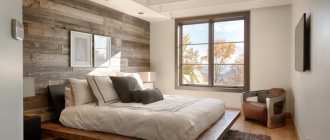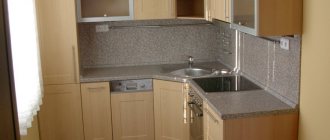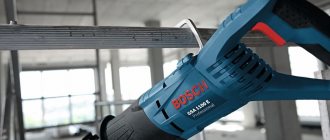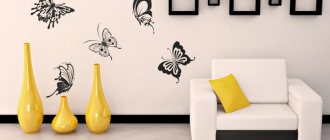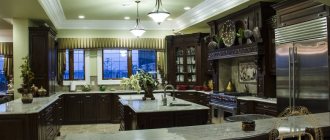Designing interior items in accordance with the style of the room is one of the integral tasks of designers in our time. The method of giving wood an aged look using various means has become especially popular.
This is explained by the fact that in the age of cars and fairly dense urban development, natural materials, such as wood, are a kind of island of safety for humans - their connection with nature. This can be achieved using brushing, which has its own secrets and features.
Wood brushing method
Wood brushing is a chemical-mechanical aging of wooden products, which can be carried out using both certain technologies and special tools. This process is quite good due to the fact that the natural aging of wood occurs for a very long time and unevenly.
Removing soft fibers from the structure of wood to reveal its natural pattern is an excellent decoration method that you can do yourself without spending a lot of money. Every person can master this method; the only condition that is required is desire and a little free time.
What is wood brushing
Brushing is a technique for artificially aging a wood surface. This finish is popular among designers. In addition, the idea of using brushed wood fits perfectly into almost any interior style.
The essence of the technology is the deliberate removal of soft fibers from a wooden surface. This is achieved using a metal brush or other tool with a hard coating. As a result, the wood acquires a richer color and pattern that reflects age rings.
The following wood species are considered more amenable to processing:
• ash;
• larch;
• oak;
• nut;
• wenge, etc.
Brushing allows you to get a patina effect when the base of the wood is painted in light colors, and the pores create contrast with dark relief lines.
Inexperienced craftsmen should take note that not every type of wood undergoes such processing. You should not start working with blanks made of alder, pear, maple, beech, and cherry.
Brushing is carried out using several methods. The most popular are mechanized processing (using an angle grinder) and manual processing, which is valued above all others. The work is carried out manually using various brushes and abrasives in combination with protective coatings.
Wood Brushing Tools
To a beginner who is not familiar with the process of working with wood, the technology of its processing may seem quite complicated and difficult. But in fact, by setting up or using a home workshop, as well as preparing the appropriate tools, you can even brush wood yourself.
This can be done without the use of technology using improvised means, or you can use the mechanization of the process. In the first case, you will only need a few things:
- several metal brushes, which have varying degrees of hardness;
- 2-3 types of sandpaper of different grain sizes;
- stain;
- varnish
Brushes are designed to clean wood from unnecessary fibers and dirt. Sandpaper is used for polishing or rough grinding. After this, stain can add brightness and color to the design, and varnish can protect the product from the influence of external mechanical damage.
You can speed up the process by mechanizing the work, for which there are many tools and devices. This type of wood processing is productive and the right choice if the surface to be decorated is too large. For small amounts of work, classic traditional brushes are suitable. The following power tools are suitable for brushing wood:
- drill with speed control;
- a brushing machine, which comes with special brushes;
- grinder with different discs and operating modes.
Often, a stripping router equipped with three types of brushes for wood processing is used as a brushing machine. They all have different structures and perform different functions:
- steel wire brushes intended directly for brushing;
- brushes made of synthetic material, which can be used for intermediate grinding;
- sisal brushes, with which you can finish polishing the entire product.
In each specific case, wood processing is carried out using certain tools that best give the desired effect. Therefore, it is necessary to make the right choice so as not to purchase and use unnecessary tools.
Types of brushes for brushing
In the brushing process, there are three stages of work - primary (roughing) processing, intermediate processing and polishing (grinding) of wood. To perform correctly, brushes of varying degrees of hardness are required, and this statement is true for both manual and electric tools. Also, aging devices vary in size, which determines their cost. Some of them are suitable not only for special brushing machines, but also for grinders due to the presence of an adapter sleeve.
Metal
Designed for rough (initial) processing of wood. The best brushes have bristles made of brass-plated steel wire. A cheaper option is all-steel brushes without brass coating. For hard rocks, you can use any product; for soft ones, you should choose brass brushes. Also among the metal tools you can see copper ones, but they are not suitable for the first stage of brushing and are intended for polishing and finishing lumber.
Brass wire brush heads
Synthetic
At the intermediate stage of brushing, nylon brushes are used. The surface after roughing remains rough and rough, and nylon fibers allow you to even out the relief. Products of various shapes and sizes are on sale, some of them are suitable for mounting on a regular angle grinder.
Nylon tools differ in the following bristles parameters:
- length;
- density;
- quantity.
Nylon nozzles for wood processing
Some models have special bristles into which abrasive particles are pressed. The grain size of the latter also varies: the more thorough the processing must be, the larger the size of abrasive grains should be selected. The hardness of nylon brushes is displayed in numbers from 120 to 600. Products with numbers 120-240 are suitable for hard breeds, and 400-600 for soft breeds.
Nylon fibers are fixed to a plastic or metal base. Despite the high strength of metal, it is plastic products that last longer. The hairs on them practically do not break, remain flexible, and therefore retain good performance characteristics for a long time.
Sisal
Such instruments are made from thin sisal fibers or from sisal fabric and cords. Externally, they can look like rings, circles, wheels for electrical appliances, or resemble ordinary paint brushes. Most products are impregnated to increase wear resistance and efficiency of use: impregnated fibers do not break at high rotation speeds. Sisal brushes are used at the final stage of brushing wood - during polishing.
Sisal brush for an angle grinder
Buying a good brush for artificially aging wood will provide a significant percentage of success and will seriously increase the chance of obtaining a high-quality product. There is no need to save money: it is better to choose a tool that will be easy to use and will last for many years!
Brands of woodworking products
Tools for working with wood are produced by both domestic and foreign companies. The most popular companies in the Russian market these days are Interskol, Makita, Jet and Triton.
Brushing wood with JET 10-20 Plus
Interskol is a domestic brand that has existed since 1991. The tools that the company produces are presented in different CIS countries and are in certain demand. The products of the Interskol company are gaining more demand every year, which is why the company is expanding its range. Brushing with Interskol
One of the leaders among the world's woodworking companies is the Japanese company Makita, founded at the beginning of the last century. Its product range includes more than a thousand items, ranging from drills and screwdrivers to machine tools and laser equipment. Brush sander Makita 9741
Cheaper tools are sold by domestic Russian companies, such as Interskol. In addition, such instruments are easier to obtain, as they are popular in the country. Foreign companies, including Makita, do not present their entire range on the Russian market, but it can be ordered without problems through official dealers and regional distributors.
A drill with a metal attachment is suitable for the home handyman.
If wood aging occurs on a large scale, you can create a special machine that will semi-automatically carry out this process. You can create it yourself or order it, for example, from Jet. Russian Interskol does not manufacture such mechanisms. The cost of such a mechanism will be quite impressive, since the machine efficiently simultaneously performs several brushing processes. It is also very important that only removable products can be used on it. If the floor or wooden part of a complex configuration is aging, the machine will not help.
Wood brushing methods
Initially, workers had to manually remove the soft fibers, gradually giving the material an aging appearance, but now many options have been invented that significantly speed up the labor-intensive process. If in artisanal production craftsmen grind the material in the old fashioned way with brushes or hand-held power tools, then in widespread production they use chemical aging methods or operate complex special machines.
Basic brushing methods:
- Manually with metal brushes.
- Power tools with abrasive attachments.
- Using woodworking machines.
- Using sandblasting equipment.
- Laser brushing of wood.
- Decorating a surface using paints or stains.
- Brushing wood by firing.
- Chemical brushing of wood by burning fibers with acids or ammonia.
Wood brushing process
Before starting work, it is necessary to slightly wet the wooden product to prevent the spread of dust during the process. After this, you need to select the appropriate tool that can remove the top fibrous layer without damaging the hard fibers. The selected brush should be moved along the grain of the wood, regardless of whether a mechanical or manual tool is used. A brush sander with different attachments and operating speeds will greatly speed up the process.
After the first process, preliminary grinding is carried out to eliminate roughness using a softer brush. In this case, the nozzle on the tool is changed to a polymer one. This cleaning can also be done with a grinder with a special type of disc. At this stage, you can decorate the product according to your wishes and give it the look it should have. Oil can help improve the appearance of wood, and you can use hand tools to create additional chips. Final polishing with an even softer brush can add uniqueness to the structure. After this, the surface is cleaned and prepared for external coating.
The next step may be a patination technique, which will paint the deep grooves a darker color. After all the necessary steps are completed, painting and varnish are applied. Before painting, you can use oil to tint. It can also be used after applying paint. Oil, wax and varnish are applied using standard technology and do not require any special precautions.
You can also age wood using various chemicals and firing using a gas burner. In the latter case, flame treatment is carried out and the darkened surface is cleaned with sandpaper. These different methods provide a huge selection of means to carry out brushing. Therefore, it is not necessary to spend a lot of money to age wood, the main thing is the optimal way to do it!
Benefits of brushing wood
Using the brushing technique has several advantages. One of the main ones is the opportunity to create an exclusive interior of the room. In addition to the unusual type of wood, this design is considered fashionable; the presentation of home renovation to acquaintances and friends will be enchanting.
A special method of processing wood makes the material resistant to external factors, insect invasion and the development of microbiological processes. Interior details made using the brushing technique look expensive and presentable. With the help of such decor, the necessary accents are placed in the room and attention is drawn to a certain area.
During the processing process, you can achieve different results: texture, pattern, color shades. Thanks to this, it becomes possible to create artificial imitation of valuable and exotic wood species. In this case, you do not have to spend a large amount of money on preparations.
Wood brushing process
A metal brush is moved along the fibers with slight, light pressure on the tool. The movements should be as if you are scraping wood until you get the look you want. It's important not to overdo it. Otherwise, instead of a beautiful, aged look of wood, you will get a damaged piece of wood.
Experienced craftsmen often use firing before brushing, since under the influence of fire, wood fibers are destroyed and can be easily removed from the surface.
But without proper experience, it is difficult to fire wood correctly. If you get distracted for a second, you can irrevocably damage the wood. Because under the influence of fire, not only the necessary fibers are destroyed, but also deeper ones. And this then affects the endurance of the tree and its service life.
Sanding after brushing
After using the brush, the wood takes on a textured, very beautiful appearance. But its texture becomes very rough. It needs to be smoothed before treating with stains and varnishes.
For grinding, after brushing, sandpaper of varying degrees of hardness is used. You need to sand along the grain of the wood, starting with coarse-grain sandpaper, then fine-grain sandpaper.
Oil and wax treatment
- linseed oil;
- beeswax;
- flute (wide flat brush);
- fine grain sandpaper;
- rags.
There are different methods for treating wood, but they have the same goal - to prevent rotting, mold, drying out, damage by insects, and also to give the surface a beautiful finished look. The use of special oils (drying oil) and beeswax allows you to preserve the structure of the material, gives it shine and strength, and increases its service life.
The depth of impregnation of linseed oil is 2 mm, which is sufficient to form a protective layer.
You can treat wood at minimal cost using linseed or hemp oil. Before starting work, it is necessary to clean the wood from dirt and dust, completely remove the previous coating, and sand the surface with fine-grain sandpaper. Experts recommend heating flaxseed oil in a water bath, but you can do without this procedure. Apply the oil either using a flute or rub it into the wood with sandpaper. It is important to follow the direction of the brush; apply oil only along the grain. The work is left for a day, after which the oil is applied again, the procedure is repeated until the desired result is achieved. Small items are immersed in oil for several days.
There are other treatments, such as coating the wood with a mixture of linseed oil and beeswax. All components are melted in a water bath, then applied to the surface with a brush or cloth. In order to give the wood a certain shade, a tint of a suitable color is added to the composition. This method has a significant drawback - very slow drying. You can speed up the process if you add a drier (sold in art stores) or purchase ready-made oil (driing oil), which contains polymerization accelerators and antifungal additives.
Color palette of hard wax for wood.
You can treat wood with only one wax. Modern industry offers colored, colorless, matte, semi-matte, glossy compositions that not only strengthen, but also favorably emphasize the texture of wood. To treat a large surface, it is necessary to heat the wax in a water bath (in this case it is applied with a wide brush). Cold wax is rubbed into the wood in a thin layer using a cloth, left for about a day, then the surface is waxed again. You can combine colorless and tinted wax, for example, treat the edges with a dark composition and the middle of the product with a transparent one. After the wax has dried, you need to polish the surface with a woolen cloth (felt).


